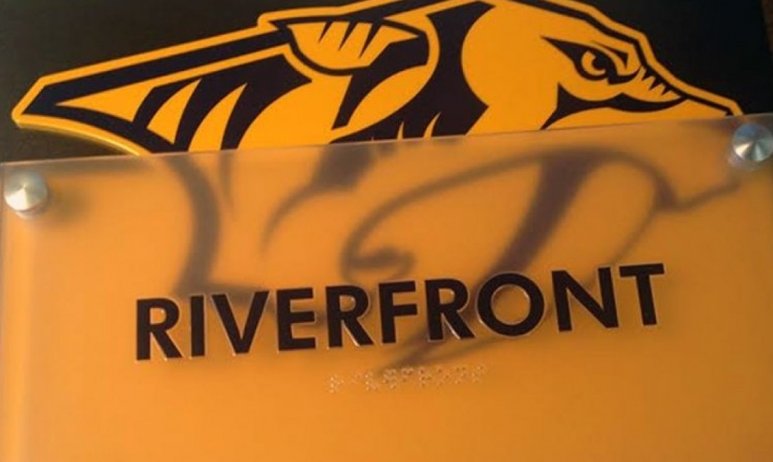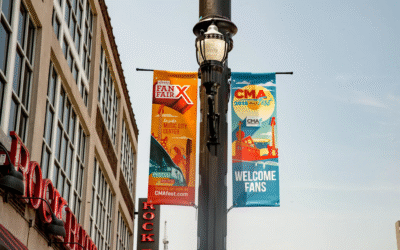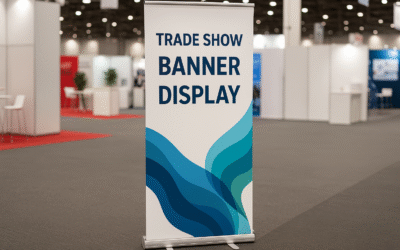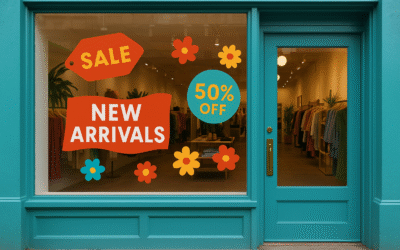Guide to Photopolymer ADA Signs
Our vast sign shop in Nashville is filled with all kinds of impressive printing and sign-finishing equipment, constantly whirring, buzzing, and humming. Though it’s not the most physically imposing machine of the bunch, one of the most well-established and technologically advanced printers at Big Visual Group is the Nova Photopolymer Processor, used to print sleek, sturdy photopolymer building signs.
If you’re unfamiliar, photopolymer signs are often used to create ADA signs that are the wayfinding signs inside buildings and indicate bathrooms, elevators, room numbers, permanent spaces and more. They include braille to meet ADA compliance. Big Visual Group offers full photopolymer signage packages to ensure that your business or building is ADA compliant.
On to the machinery! Photopolymer signs are created by transposing a digital image to a film negative, putting it on a photopolymer sheet, exposing it to ultraviolet light, washing it, drying it, and exposing it again. Easy enough, right? No? Let’s break it down a little further.
Photopolymer Sign Materials
Photopolymer is a synthetic compound that hardens when exposed to UV light. Big Visual uses 19″ x 24″ sheets with an acrylic base, of various thicknesses, that’s topped by the 1/32-inch photopolymer sheet.
Photopolymer Sign Process
First, the sign is designed to fit specifications (approved by the client) on a computer. The image is mirrored (so it appears to be backward), and lettering must be in black (color is not added to the sign until the very end) on the clear film. A number of different photopolymer signs fit on the same sheet and go through the process simultaneously. (Printing one sign at a time would be costly and tedious).
In a process that is not unlike Tetris, multiple signs must be moved around in the prepress phase to fit onto the single sheet of film. Once all the images of signs are aligned, they are printed on the film.
The black and clear film negative is then placed atop the photopolymer sheet, and it’s ready to be exposed in the Nova Photopolymer Processor. After it’s vacuum-sealed (you don’t want any air between the negative and the sheet), it’s exposed to ultraviolet light for 5 minutes. Light passes through everything but the black lettering (which blocks the light), hardening the clear parts of the film.
After it’s been exposed, it goes into a wash tank where oscillating bristles rinse it with tap water, dissolving the emulsion and leaving behind everything that was hardened by the light: your raised text and braille. The sheet then goes into a drying drawer on the machine for 15-20 minutes. For one final curing, the sheet undergoes the UV exposure process one more time, hardening the clear parts of the photopolymer.
The black and clear sheet with the transferred image then dries for 24 hours before it is sent away for routing: cutting out the individual signs from the sheets. Last, the signs are sent to the paint department, where, yes, they will receive a little color via a spray and wipe method, so that the lettering and background of the signs are different colors.
A completed photopolymer ADA sign (go Preds!)
Advantages of Photopolymer Printed Signs
One obvious advantage of photopolymer ADA signs is that they look clean, vivid and sleek. Aside from aesthetics, this process is desirable because it’s quicker and more cost-efficient than routing and engraving methods to create braille signs. Big Visual Group can turn around an ADA-compliant building sign project in 10 days with this technology.
Another distinct advantage to printing with photopolymer sheets is that the letters and braille cannot be removed from signs. It’s an unfortunate part of human nature, but people pick letters off signs all the time, whether out of boredom or for various mischievous reasons. With photopolymer signs, letters and dots are not attached with adhesive and cannot be removed, thus remaining ADA compliant.
We hope this gives you some insight into how we produce photopolymer at Big Visual Group. If you need to refresh your ADA and wayfinding signs and are interested in using photopolymer, holler at us for assistance.
You may also be interested in:
Retail Rollouts Done Right: How to Maintain Brand Consistency Across Locations
Expanding your retail brand from one location to many is a major milestone, but it brings new challenges for maintaining a consistent look and feel. What makes your flagship store special can quickly lose impact if colors, materials, or displays vary from one location...
A Buyer’s Guide to Banner Frame Systems: Types, Features & Use Cases
Find the Right Banner Frame System to Maximize Your Message Whether you're preparing for a trade show, storefront promo, or corporate event, choosing the right banner frame system can make or break your display’s effectiveness. At Big Visual Group, we’ve installed...
How to Use Custom Window Graphics to Increase Storefront Foot Traffic
Attract More Customers with Strategic Window Decals Your storefront is the first impression your business makes—and if it's not eye-catching, you're missing opportunities. Custom window graphics offer a cost-effective, high-visibility solution to transform...





